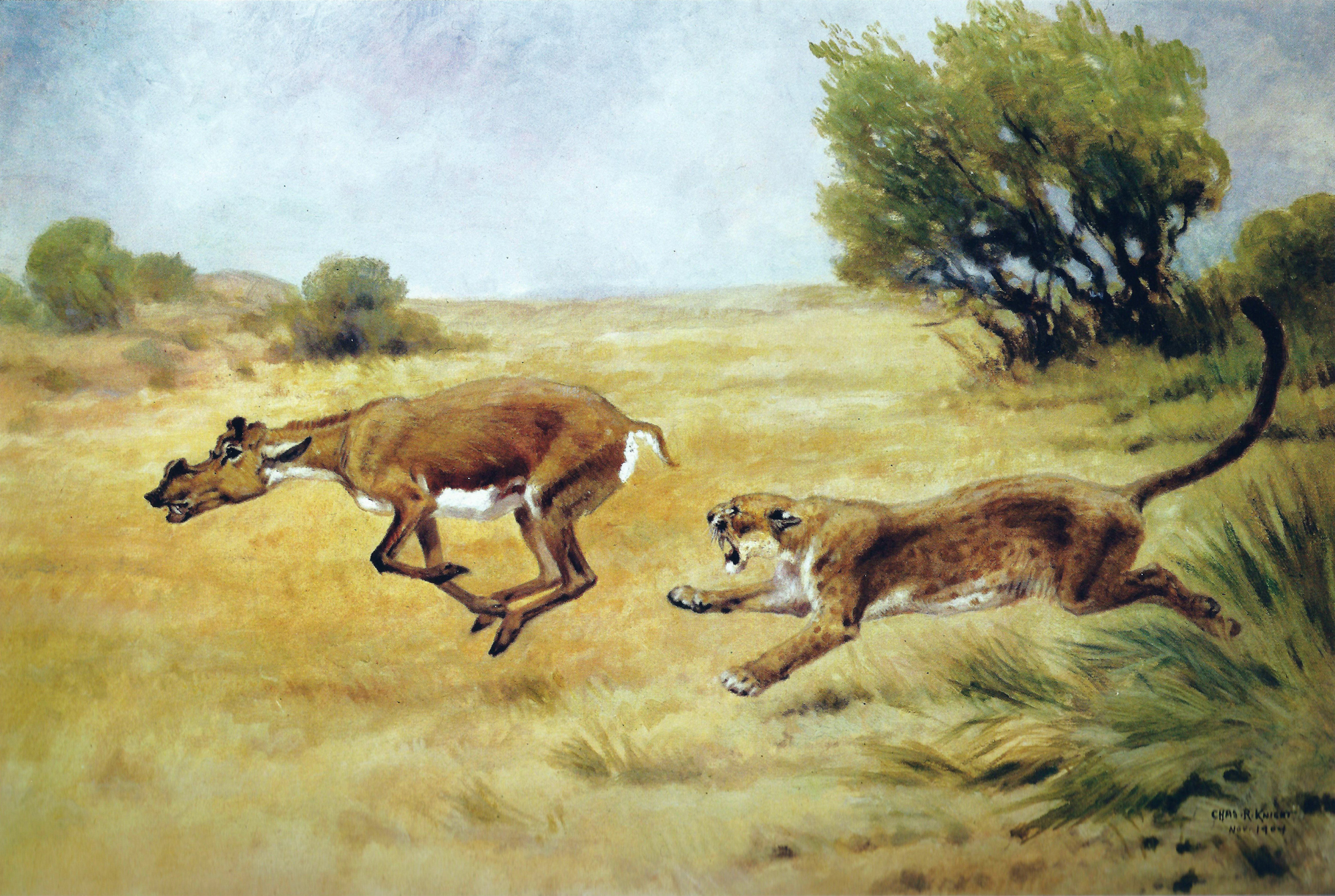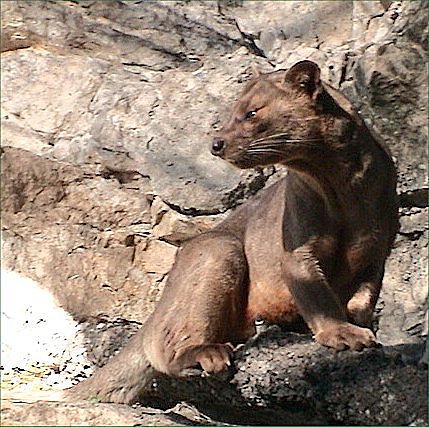|
Nimravid
Nimravidae is an extinct family of carnivorans, sometimes known as false saber-toothed cats, whose fossils are found in North America and Eurasia. Not considered to belong to the true cats (family Felidae), the nimravids are generally considered closely related and classified as a distinct family in the suborder Feliformia. Fossils have been dated from the Middle Eocene through the Late Miocene epochs (Bartonian through Tortonian stages, 40.4–7.2 million years ago), spanning about . The barbourofelids, which were formerly classified as a subfamily of the Nimravidae, were reassigned to their own distinct family Barbourofelidae in 2004. However, some recent studies suggest the barbourofelids are a branch of the nimravids, suggesting that this debate might not be settled yet. Morphology and evolution Most nimravids had muscular, low-slung, cat-like bodies, with shorter legs and tails than are typical of cats. Unlike extant Feliformia, the nimravids had a different bone structu ... [...More Info...] [...Related Items...] OR: [Wikipedia] [Google] [Baidu] |
Eusmilus
''Eusmilus'' ('true sabre') is a prehistoric genus of nimravid that lived in Europe during the Late Eocene to Early Oligocene epochs (37.2–28.4 mya). Taxonomy There are three valid species of ''Eusmilus'', ''E. bidentatus'' and ''E. villebramarensis''. ''Ekgmoiteptecela'' MacDonald, 1963 was synonymized with ''Eusmilus'' by some authors, but is actually synonymous with '' Hoplophoneus''. The third species, ''E. adelos'', was described in 2021, and stands as the largest species in the genus. One study performed in 2016 suggests that ''Eusmilus'' is a non-valid genus, and moved all North American species to '' Hoplophoneus''. The discovery of ''E. adelos'' meanwhile, suggests that nimravids went along derived evolutionary pathways; conical-toothed, dirk-toothed, and scimitar-toothed, with and that their evolutionary paths split in two, leading to saber-toothed and conical-tooth forms that convergently evolved with those of true felids tens of millions of years later. Mor ... [...More Info...] [...Related Items...] OR: [Wikipedia] [Google] [Baidu] |
Nanosmilus
''Nanosmilus'' is a nimravid from the Oligocene ( Whitneyan to Arikareean stages) of Nebraska. As a member of Feliformia, it is related to the superficially similar-appearing true cats. As such, it and nimravid genera in general are often referred to as false saber-toothed cats. No larger than a small bobcat, it is the smallest known saber-toothed mammal currently recognized by science. It is most closely related to its fellow nimravid ''Eusmilus''. Description ''Nanosmilus'' was first discovered in 1880, by Edward Drinker Cope, and described from fragmentary material. It wasn't until more complete skulls were discovered that ''Nanosmilus'' became better known to science. For many decades, it was thought to be a member of the genus ''Eusmilus'' and was labelled as ''Eusmilus cerebralis''. Its similarities to ''Eusmilus'' are such that they were often considered to be members of the same genus as recently as 2013; however, a 2016 phylogenetic analysis found it to be a separate ... [...More Info...] [...Related Items...] OR: [Wikipedia] [Google] [Baidu] |
Pangurban
''Pangurban'' is an extinct genus of the family Nimravidae (the false saber-toothed cats), endemic to North America during the Eocene epoch (40–37 mya). It contains a single species, ''Pangurban egiae''. Occurring several million years before other named nimravids in North America, the discovery of this species suggests that hypercarnivores evolved and spread quickly after the warm middle Eocene. Etymology The namesake for the generic name ''Pangurban'' comes from the eponymous white cat in the anonymous 9th century Irish poem Pangur Bán. The species name honors scientist Naoko Egi. Description ''P. egiae'' would have been cat-like in many respects, though since the holotype is incomplete most description would require comparison with close relatives. Using tooth dimensions, the body mass was estimated to be . The species may have been the size of the smallest mountain lions. Due to the close relationship with the better known nimravid Hoplophoneus ''Hoplophoneus'' ... [...More Info...] [...Related Items...] OR: [Wikipedia] [Google] [Baidu] |
Carnivora
Carnivora is a monophyletic order of placental mammals consisting of the most recent common ancestor of all cat-like and dog-like animals, and all descendants of that ancestor. Members of this group are formally referred to as carnivorans, and have evolved to specialize in eating flesh. The order is the fifth largest order of mammals, comprising at least 279 species. Carnivorans live on every major landmass and in a variety of habitats, ranging from the cold polar regions to the hyper-arid region of the Sahara Desert to the open seas. They come in a very large array of different body plans in contrasting shapes and sizes. Carnivora can be divided into two subclades: the cat-like Feliformia and the dog-like Caniformia, which are differentiated based on the structure of their ear bones and cranial features. The feliforms include families such as the cats, the hyenas, the mongooses and the civets. The majority of feliform species are found in the Old World, though the cat ... [...More Info...] [...Related Items...] OR: [Wikipedia] [Google] [Baidu] |
Maofelis
''Maofelis cantonensis'' is an extinct basal nimravid from Late Eocene-aged Youganwo Formation of Maoming Basin, Guangdong Province, China China, officially the People's Republic of China (PRC), is a country in East Asia. It is the world's most populous country, with a population exceeding 1.4 billion, slightly ahead of India. China spans the equivalent of five time zones and .... References Prehistoric mammals of Asia Nimravidae Eocene carnivorans Fossil taxa described in 2016 Paleontology in Guangdong Prehistoric carnivoran genera {{paleo-carnivora-stub ... [...More Info...] [...Related Items...] OR: [Wikipedia] [Google] [Baidu] |
Hoplophoneus
''Hoplophoneus'' (Greek: "murder" (phonos), "weapon" (hoplo)) is an extinct genus of the family Nimravidae, endemic to North America during the Late Eocene to Early Oligocene epochs (35–29 mya), existing for approximately . Taxonomy In 2016, all North American species of '' Eusmilus'' were placed in ''Hoplophoneus'' by Paul Z. Barrett. Description ''Hoplophoneus'', though not a true cat, was similar to cats in outward appearance, though with a robust body and shorter legs. The largest known specimen was examined by Sorkin (2008) for body mass and was estimated to have a weight of . ''Hoplophoneus occidentalis'' was about the size of a large leopard The leopard (''Panthera pardus'') is one of the five extant species in the genus '' Panthera'', a member of the cat family, Felidae. It occurs in a wide range in sub-Saharan Africa, in some parts of Western and Central Asia, Southern Russia, a ... and had canine teeth of only moderately-larger size. The larger ''H. si ... [...More Info...] [...Related Items...] OR: [Wikipedia] [Google] [Baidu] |
Barbourofelid
Barbourofelidae is an extinct family of carnivorans of the suborder Feliformia, sometimes known as false saber-toothed cats, that lived in North America, Eurasia and Africa during the Miocene epoch (16.9—9.0 million years ago) and existed for about . Taxonomy The type genus, ''Barbourofelis'', was originally described by Schultz et al. (1970) and assigned to a new tribe, Barbourofelini, within the felid subfamily Machairodontinae, along with the other sabre-toothed cats. Subsequently, the tribe was reassigned to the Nimravidae by Tedford (1978) and raised to a subfamily by Bryant (1991). However, a number of studies in the early 2000s identified a closer affinity of the barbourofelines to the Felidae than to the Nimravidae and they were reranked as a distinct family by Morlo et al. (2004). Since then the prevailing view has the barbourofelids as the sister group to the Felidae, although this has recently been challenged, following the description of the middle Miocene genus ' ... [...More Info...] [...Related Items...] OR: [Wikipedia] [Google] [Baidu] |
Middle Eocene
The Eocene ( ) Epoch is a geological epoch that lasted from about 56 to 33.9 million years ago (mya). It is the second epoch of the Paleogene Period in the modern Cenozoic Era. The name ''Eocene'' comes from the Ancient Greek (''ēṓs'', "dawn") and (''kainós'', "new") and refers to the "dawn" of modern ('new') fauna that appeared during the epoch. The Eocene spans the time from the end of the Paleocene Epoch to the beginning of the Oligocene Epoch. The start of the Eocene is marked by a brief period in which the concentration of the carbon isotope 13C in the atmosphere was exceptionally low in comparison with the more common isotope 12C. The end is set at a major extinction event called the ''Grande Coupure'' (the "Great Break" in continuity) or the Eocene–Oligocene extinction event, which may be related to the impact of one or more large bolides in Siberia and in what is now Chesapeake Bay. As with other geologic periods, the strata that define the start and end ... [...More Info...] [...Related Items...] OR: [Wikipedia] [Google] [Baidu] |
Feliformia
Feliformia is a suborder within the order Carnivora consisting of "cat-like" carnivorans, including cats (large and small), hyenas, mongooses, viverrids, and related taxa. Feliformia stands in contrast to the other suborder of Carnivora, Caniformia (also Canoidea, "dog-like" carnivorans). The separation of the Carnivora into the broad groups of feliforms and caniforms is widely accepted, as is the definition of Feliformia and Caniformia as suborders (sometimes superfamilies). The classification of feliforms as part of the Feliformia suborder or under separate groupings continues to evolve. Systematic classifications dealing with only extant taxa include all feliforms into the Feliformia suborder, though variations exist in the definition and grouping of families and genera.Taxonomic references - extant species (1): Supporting descriptive information and picturesDiversity Web (online) – Feliformia/ref>Taxonomic references - extant species (2)Integrated Taxonomic Information Sy ... [...More Info...] [...Related Items...] OR: [Wikipedia] [Google] [Baidu] |
Miocene
The Miocene ( ) is the first geological epoch of the Neogene Period and extends from about (Ma). The Miocene was named by Scottish geologist Charles Lyell; the name comes from the Greek words (', "less") and (', "new") and means "less recent" because it has 18% fewer modern marine invertebrates than the Pliocene has. The Miocene is preceded by the Oligocene and is followed by the Pliocene. As Earth went from the Oligocene through the Miocene and into the Pliocene, the climate slowly cooled towards a series of ice ages. The Miocene boundaries are not marked by a single distinct global event but consist rather of regionally defined boundaries between the warmer Oligocene and the cooler Pliocene Epoch. During the Early Miocene, the Arabian Peninsula collided with Eurasia, severing the connection between the Mediterranean and Indian Ocean, and allowing a faunal interchange to occur between Eurasia and Africa, including the dispersal of proboscideans into Eurasia. During the la ... [...More Info...] [...Related Items...] OR: [Wikipedia] [Google] [Baidu] |

.jpg)


